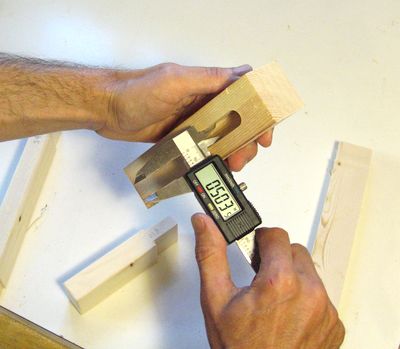 Measuring the mortise is a bit tricky. The internal jaws of a typical caliper don't have
very much contact area, and the wood is not as rigid as metal. Its also easy to have the caliper
not inserted entirely straight.
Measuring the mortise is a bit tricky. The internal jaws of a typical caliper don't have
very much contact area, and the wood is not as rigid as metal. Its also easy to have the caliper
not inserted entirely straight.
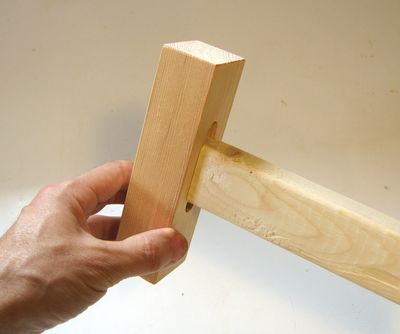 Ideally, a mortise and tenon joint is tight enough that friction will hold the tenon
in the mortise when dry fitting. But it should also be loose enough that it can be
inserted by hand without a lot of effort. I always aim for this sort of fit. I finally
decided to do some experiments to see how much latitude I have in terms of accuracy
for the tenon size to still have a good fit.
Ideally, a mortise and tenon joint is tight enough that friction will hold the tenon
in the mortise when dry fitting. But it should also be loose enough that it can be
inserted by hand without a lot of effort. I always aim for this sort of fit. I finally
decided to do some experiments to see how much latitude I have in terms of accuracy
for the tenon size to still have a good fit.
I started by making a mortise and tenon joint that fits just right, and measured it.
 Measuring the mortise is a bit tricky. The internal jaws of a typical caliper don't have
very much contact area, and the wood is not as rigid as metal. Its also easy to have the caliper
not inserted entirely straight.
Measuring the mortise is a bit tricky. The internal jaws of a typical caliper don't have
very much contact area, and the wood is not as rigid as metal. Its also easy to have the caliper
not inserted entirely straight.
Another interesting thing I found is that every one of my calipers would measure about 0.003" too small on inside measurements when I checked them against a trusted micrometer. I fixed them to be exact by grinding away a few thou from the inside measurement jaws with a few strokes of a small sharpening stone.
My mortise had a width of 0.503", 0.003" larger than the nominal dimension of my 1/2" router bit.
I'm using inches in my measurements in this article, because the router bits are in inches, and so is the dial indicator on my tenon jig. 40 thou, or 0.040" (inches) is one millimeter.
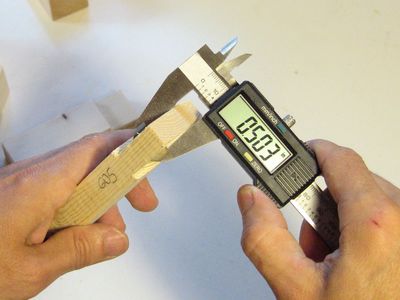 Measuring the tenon. The tenons are much easier to measure. The perfectly fitting tenon
measured 0.503". I set my tenon jig to move 0.605" between cuts. About 0.102" was taken
up by the blade kerf, leaving the 0.503" for the tenon.
Measuring the tenon. The tenons are much easier to measure. The perfectly fitting tenon
measured 0.503". I set my tenon jig to move 0.605" between cuts. About 0.102" was taken
up by the blade kerf, leaving the 0.503" for the tenon.
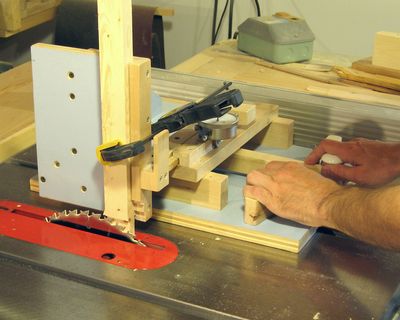 I use my quick set tenon jig to cut the tenons accurately. With
the dial indicator I attached to it, I can very precisely determine the distance between
the two cuts of the saw blade. I made several tenons of different thicknesses to test with:
I use my quick set tenon jig to cut the tenons accurately. With
the dial indicator I attached to it, I can very precisely determine the distance between
the two cuts of the saw blade. I made several tenons of different thicknesses to test with:
| Cut spacing | Tenon thickness | Difference |
|---|---|---|
| 0.590" | 0.488" | 0.102" |
| 0.595" | 0.491" | 0.104" |
| 0.600" | 0.497" | 0.103" |
| 0.605" | 0.502" | 0.103" |
| 0.610" | 0.508" | 0.102" |
The rightmost column is the difference between cut spacing and tenon thickness. This difference is the result of my blade, which for this application, cuts a kerf about 0.103" wide. My cuts were very consistent. However, when cutting tenons on narrow pieces of hardwood, sometimes I get a fair bit of blade vibration, which completely messes up the accuracy.
Its possible to do fairly accurate tenons with an ordinary tenon jig as well, it just takes more time. The key thing to keep in mind is to be consistent how you push it across (so thatthe play is always the same way), and to set up for the other side of the tenons by doing a readjustment of the jig, as opposed to flipping over the work piece. If you flip the workpiece, inacurracies in the work piece contribute to errors in the tenon thickness.
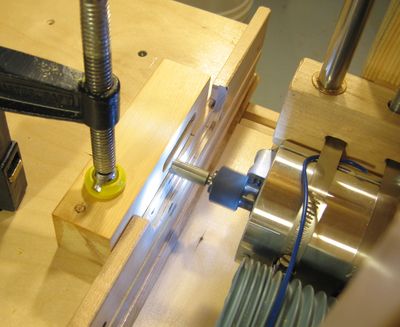 I cut my mortises very accurately using my home made slot
mortising machine. It's essentially a contraption that allows very precise control
of a router. A router can cut more accurately than a square chisel mortiser, because
the cutting forces involved are much smaller. That said, the last time I used a hollow
chisel mortiser was back in highschool, so I can't really make comparison measurements.
I have had good experience experinenting with this simple mortising
jig.
I cut my mortises very accurately using my home made slot
mortising machine. It's essentially a contraption that allows very precise control
of a router. A router can cut more accurately than a square chisel mortiser, because
the cutting forces involved are much smaller. That said, the last time I used a hollow
chisel mortiser was back in highschool, so I can't really make comparison measurements.
I have had good experience experinenting with this simple mortising
jig.
If I cut slowly with the 1/2" router bit shown, I get a mortise of about 0.503 - 0.504" wide. But if I cut fast the forces and deflection are a little bit more, and I end up with a mortise that is around 0.508" wide. The important thing is to be consistent about how all the mortises in a project are cut. I usually just cut all of them fast.
With a mortise of 0.503", here's how the tenons fit:
| Tenon Thickness | Resulting Fit |
|---|---|
| 0.488 | Very loose, with some play |
| 0.491 | Very loose, still some play |
| 0.497 | A very small amount of friction, but falls out from gravity. |
| 0.502 | Just the right fit. |
| 0.508 | Doesn't fit (would have to be hammered in) |
The tenon with 0.497" would be barely ok. The tenon with 0.502" was a perfect fit, and the tenon with 0.508 I would have had to drive in with a mallet.
It's a bad idea to have to drive tenons in with a mallet. Doing so will scrape much of the glue off the contact surface. Out of paranoia, I always apply glue to the mortise and the tenon, for fear that if I do end up scraping out the glue, at least there will still some glue in the pores of both pieces.
Realistically, the total range of latitude is about 0.005" for a good fit. And this
is using spruce, which is a very forgiving soft wood. For mortise and tenon joints
in hardwoods, accuracy is even more critical.
See also:
More on mortise and tenon joinery